The Intrinsic and Market Value of Platinum Rings
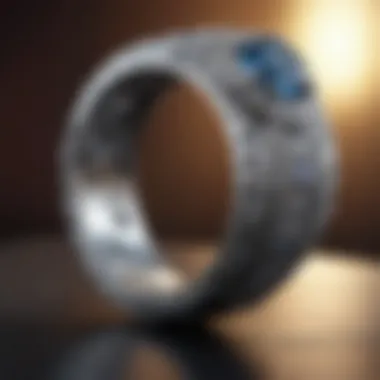
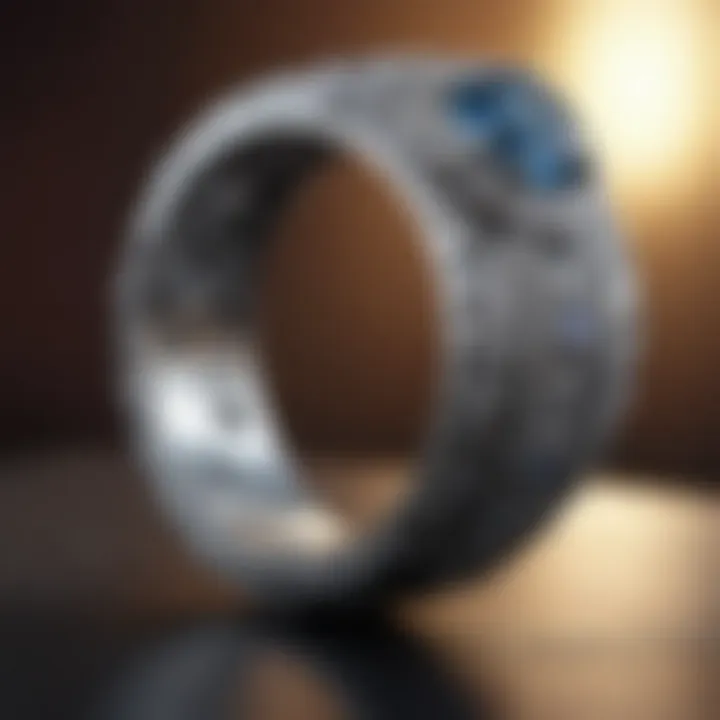
Intro
In the realm of fine jewelry, platinum rings hold a notable place of prestige. Considered a symbol of commitment, luxury, and durability, they often evoke strong emotions for those who wear them. But what exactly makes platinum rings so valuable? This discussion aims to dissect the intrinsic and market value surrounding these exquisite pieces by exploring various factors that influence their worth.
From composition and craftsmanship to current market trends, understanding the nuances of platinum as a material will afford potential buyers insightful perspectives when making informed jewelry purchases. For enthusiasts and collectors alike, delving into the world of platinum rings goes beyond their dazzling aesthetics; it’s about comprehending their true worth in both sentimental and financial terms.
Gemstone Overview
Definition of Gemstones
Gemstones can be defined as naturally occurring minerals that are prized for their beauty, rarity, and durability. Typically used in the making of jewelry, gems are cut and polished to enhance their appeal. Platinum, while not a gemstone in the traditional sense, is often associated with precious stones like diamonds, which are set in platinum jewelry. The enduring aesthetic of platinum enhances the brilliance of these gemstones, allowing for a striking presentation.
Classification of Gemstones
Gemstones are commonly classified based on their composition, origin, and beauty. Here are a few key classifications:
- Precious Stones: These include diamonds, rubies, sapphires, and emeralds, known for their rarity and high value.
- Semi-Precious Stones: These stones, like amethyst, aquamarine, and garnet, are also beautiful but less rare than precious stones.
- Organic Gems: These originate from living organisms, such as pearls and coral.
Each of these categories holds its significance in the jewelry market, yet their marriage with platinum enhances their allure and can drastically affect the overall value and desirability of the piece.
Historical Significance
Origins of Gemstone Use
The use of gemstones dates back thousands of years. Ancient civilizations adorned themselves with gems not merely to showcase wealth but also for their believed mystical properties. The Greeks, for instance, considered gemstones to possess powers that could influence fortunes. As a touchstone throughout history, gems have often reflected societal values and shifts, underlining their importance beyond mere decoration.
Cultural Insights: Gemstones in Ancient Civilizations
In various cultures, gemstones have played pivotal roles:
- Egyptians: They used turquoise and lapis lazuli in jewelry, signifying protection and power.
- Romans: Believed sapphires could guard against envy, highlighting their high regard for amulets.
- India: The rich history of gemstones paved the way for elaborate designs in royal jewelry.
Not only has platinum served as a stunning foundation for these gems in modern settings, but it also echoes historical significance in its enduring strength and luster.
As we navigate through this article, we will further explore the intricate workings of platinum rings, diving deeper into factors like market trends and craftsmanship.
Prelude to Platinum Rings
One of the reasons why platinum stands out in the jewelry realm is its rarity and unique physical properties. For gemstone enthusiasts and collectors, recognizing what makes platinum desirable—such as its durability and hypoallergenic qualities—can provide invaluable insight into both personal and market value.
Additionally, one cannot overlook the craftsmanship behind these rings. The skill it takes to mold and design a platinum ring is often showcased in its complexity, making each piece not just a ring, but a piece of art. This complexity also adds layers to its worth, presenting further consideration when making a purchase.
As we journey through the alluring history, the technical properties, and the valuation methods of platinum rings, readers will grasp essential information that will aid in making informed decisions—be it in purchasing a stunning piece or appreciating the artistry involved in its creation.
The Allure of Platinum
Platinum is often called the king of metals, holding a charm that few other materials can replicate. Its natural white hue complements a variety of gemstones, particularly diamonds, enhancing their sparkle without overshadowing them. The very essence of platinum rings embodies a certain je ne sais quoi, an intangible quality that fascinates not only wearers but also observers.
The weight of a platinum ring speaks volumes; it feels substantial, almost as if it carries the promise of longevity. This inherent weight stems from its density, making platinum rings easily recognizable and memorable. Moreover, the metal's natural luster adds a soft glow that often intrigues the beholder, keeping them coming back for more.
Beyond its physical beauty, there's an emotional undertone to platinum that connects it with milestones and memories, rendering it the metal of choice for many engagement and wedding rings. Couples often associate platinum with strength and endurance, mirroring the very qualities they wish to bring into their union.
Historical Significance
Platinum has held a prominent position in history, often seen as the preferred metal among royalty and the elite. It wasn't until the 18th century that it began to be acknowledged by jewelers in Europe, leading to a surge in its popularity. Initially, it was considered a nuisance by some due to its difficulty to work with, but this very characteristic elevated its status over time.
In various cultures, platinum has been seen as a symbol of purity and wealth. For instance, during the reign of the Louis XVI, this metal took center stage, being frequently used in royal jewelry and artifacts. Its appeal traversed continents, influencing jewelry trends and elevating tastes. In modern times, this historical reverence still plays a vital role in consumer perception, as buyers are often drawn to the stories and heritage intertwined with platinum's rich past.
Understanding the historical significance provides a broader context to its value today. Knowing that a platinum ring one wears or gives symbolizes a connection to a deeper lineage of opulence can add both sentimental and intrinsic worth.
Composition and Properties of Platinum
Understanding the composition and properties of platinum rings is critical when assessing their value. Platinum, as a metal, carries unique characteristics that set it apart from gold, silver, and other alloys. The purity of the metal, how it is alloyed, and its physical traits all contribute to its desirability and worth. In this article, we will explore these aspects in depth, including how they affect everything from crafting to market trends.
Purity and Alloying
Platinum is often referred to as one of the purest and most prestigious metals in the jewelry industry. When it comes to purity, platinum rings usually come in several grades, with the most common being 950 or 900 parts per thousand of platinum content. The remaining percentage includes alloy metals such as iridium, ruthenium, or palladium. This mixture not only enhances the durability of platinum but also maintains its characteristic sheen.
One major consideration surrounding purity is how these alloying elements can affect price and performance. For instance, rings made of 950 platinum typically exhibit heavier weight and a higher price point. Conversely, alloyed platinum might be more affordable and lightweight but at the cost of some durability. In terms of value, buyers should always check the purity stamp – typically marked on the inner band – to know what they are investing in.

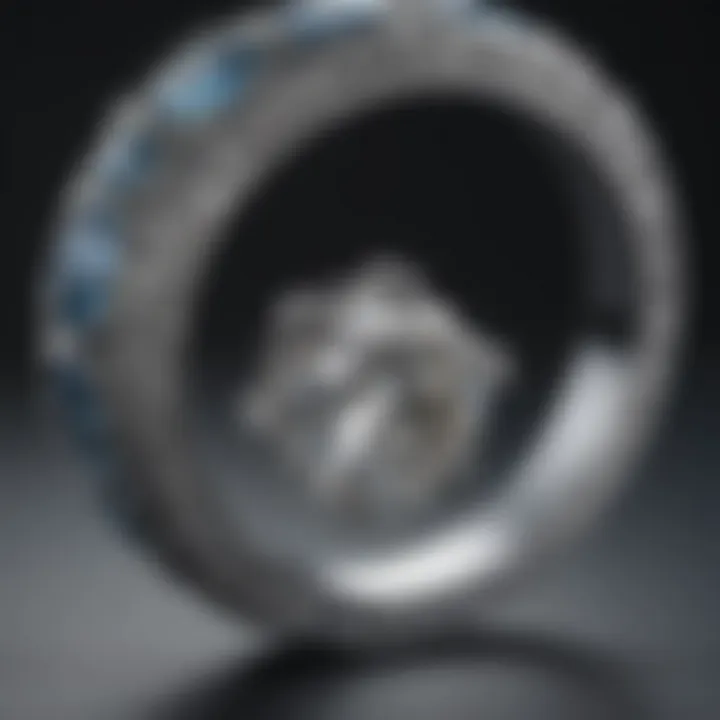
Physical Characteristics
The allure of platinum goes beyond its lustrous appearance; its physical characteristics solidify its status in the market.
Color and Luster
Platinum carries a natural white sheen that is distinct from yellow gold or silver. Its color isn’t just flashy—it's often described as a soft, silvery-white, which complements various gemstones superbly. However, what truly makes platinum desirable in this regard is its ability to maintain luster over time. Unlike white gold, which is often rhodium plated to achieve its color only to tarnish over time, platinum’s hue sticks around. Another factor to consider is its resistance to fading, providing long-lasting beauty.
Platinum's brightness and reflective quality make it particularly favorable for highlighting precious stones. This dual functionality of being both beautiful and practical solidifies its appeal among jewelry designers.
Durability and Scratch Resistance
One of the selling points of platinum is its exceptional durability. It rates high on the Mohs scale, indicating a robust resistance to scratches and dents. When something’s built to withstand wear-and-tear, it becomes an attractive option for everyday jewelry like engagement and wedding rings. As time passes, the very nature of platinum means it does not wear away like gold. Instead, it forms a natural patina that many find appealing.
However, while platinum is tough, it isn't immune to scuffs or marks. Some argue that a more pronounced patina adds character, giving the piece an artisanal feel over time, while others may prefer periodic polishing to revert it back to its original shine. This durability ultimately enhances the ring’s investment value, as it will maintain its structural integrity and aesthetic appeal over many decades.
Weight Factors
Weight is another key characteristic to consider when evaluating platinum. While most people might favor lighter jewelry, the weight of platinum rings can be a testament to their thickness and quality. Being one of the denser precious metals, platinum rings often feel more substantial on the finger compared to other metals. This heft can be reassuring; it signals that one is wearing a higher-quality item rather than something hollowed out or cheaply made.
The unique feature of a platinum ring's weight can also influence comfort levels. Some wearers appreciate this heft as a sign of luxury, while others might find it weighty and constricting over the long haul.
In summary, the composition and properties of platinum rings not only determine their quality but also greatly inform their market value. As seen, attributes such as purity, physical characteristics, including color, durability, and weight, ultimately define what many consider to be a sound investment in luxury jewelry.
Factors Influencing the Worth of Platinum Rings
The value of platinum rings doesn’t solely hinge on the metal itself. Multiple elements come into play here, impacting their worth significantly. Understanding these factors is crucial for anyone interested in making informed purchases or investments in platinum jewelry. In essence, everything from market conditions to the artistry behind the piece shapes its value.
Market Trends and Demand
Market trends are essentially the heartbeat of how well any commodity does, platinum rings included. Factors such as economic conditions and supply fluctuations often give us a peek into the overall demand for platinum. When the economy is thriving, people are more inclined to splurge on luxury items like rings, driving the prices up. Conversely, during economic downturns, the demand often wanes, affecting the overall market price.
Additionally, the mining output of platinum plays a pivotal role. For example, should geopolitical issues arise in major mining regions, it could lead to supply shortages, consequently driving up the prices. Similarly, if new sources of platinum are found, flooding the market, the price might drop significantly. Therefore, keeping an eye on global events and stock indices can provide insight into future trends.
Craftsmanship and Design Complexity
When it comes to platinum rings, craftsmanship is no small matter. The level of artisanship involved can make a world of difference in how much a ring is worth. Jewelers who specialize in fine craft possess skills that are nuanced and sophisticated. Custom designs or intricate settings can elevate a piece beyond standard fare, reflecting not just high quality but personal expression as well.
For instance, a simple, minimalist platinum band might have a lower price point compared to a uniquely designed ring that features filigree or custom engraving. Each element added doesn’t just enhance visual appeal; it tells a story and can significantly impact the sentimental value, which in turn can lead to a greater financial worth.
In addition, as fashion shifts over time, certain design trends may gain favor, thereby affecting demand for specific styles of platinum rings. Jewelers must remain attuned to current trends in order to create pieces that resonate with potential buyers, thus enhancing their market value.
Gemstone Settings and Enhancements
Finally, the presence of gemstones in platinum rings cannot be underestimated. Platinum, known for its sturdiness, often acts as the ideal setting for various gemstones, including diamonds, sapphires, or emeralds. The type, quality, and size of the gemstones directly affect the ring's valuation.
For instance, a platinum ring adorned with a high-quality, large diamond will naturally command a higher price than a simple platinum band. Factors such as clarity, cut, and certification of the gemstones also matter significantly. Many savvy buyers often look for rings that not only showcase the brilliance of the platinum but also the vibrancy of the stones.
Moreover, enhanced features, such as colored gems or unique cutting styles, further diversify the aesthetic appeal, allowing for personal expression. This combination creates a more dynamic market, as buyers are often willing to pay a premium for unique or rare gemstone settings.
"The value of a platinum ring is often a multi-layered assessment, influenced by market fluctuations, craftsmanship, and the types of gemstones present."
In summary, the worth of platinum rings is a complex interweaving of several factors. Market trends inform us about demand, the craftsmanship illustrates the quality, and the amount and quality of gemstones provide the final touches to valuation. With all these elements taken into account, one can appreciate the multifaceted nature of your investment.
Valuation Techniques
Valuation techniques are pivotal in determining the reasonable worth of platinum rings, a material prized for its rarity and beauty. Understanding these techniques not only empowers buyers but also helps sellers position their goods effectively in a competitive market. The nuances of valuing platinum are multifaceted, encompassing everything from purity levels to market trends. Each valuation technique offers unique benefits and insights, contributing to a well-rounded understanding of what influences price.
Appraisal Methods
When it comes to valuing platinum rings, appraisal methods stand at the forefront. An appraisal typically involves evaluating a ring's characteristics, such as its metal purity, design complexity, and any gemstone enhancements. Professional appraisers often follow a standardized approach, ensuring that all aspects of the piece are scrutinized.
In most cases, an appraisal can be based on:
- Intrinsic Value: This refers to the metal's composition—platinum's purity, for instance, heavily influences its valuation. Generally, higher purity alloys, like 950 platinum, command better prices than their lower-grade counterparts.
- Market Comparison: Appraisers often compare the item with recent sales of similar pieces. This method leverages the idea that what buyers are willing to pay informs the market value.
- Retail Replacement Value: This is an estimation of what a buyer should expect to pay for a similar item in a retail setting.
"A proper appraisal is an investment unto itself, providing clarity in a maze of market fluctuations."
Having a reliable appraisal is beneficial for various reasons such as ensuring proper insurance coverage and making informed selling decisions. One must consider obtaining multiple appraisals to get a well-rounded view of the ring's value, as different appraisers may arrive at varied conclusions based on their methodologies.
Comparative Price Analysis
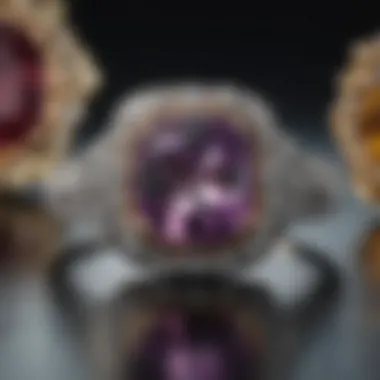
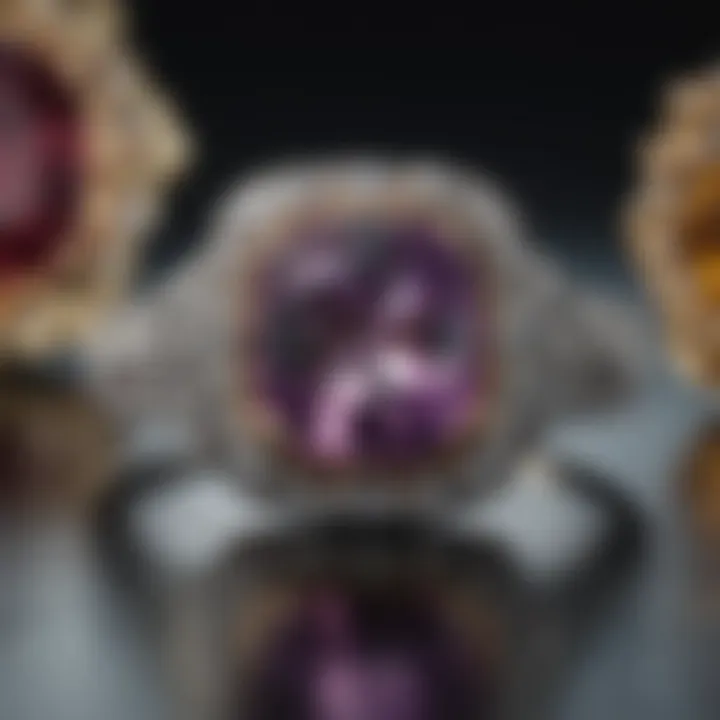
Comparative price analysis acts as a practical guide for determining the market value of platinum rings by comparing prices from various sources. This strategy gives insight into average market trends and fluctuations, leading to smarter purchasing or selling choices.
This analysis can involve:
- Online Marketplaces: Websites like eBay or those specializing in jewelry often showcase a plethora of platinum rings. By observing prices for similar styles, buyers can gauge if an offered price is fair.
- Auction Houses: Auctions can present unique insights into market demand and pricing; watching how particular items perform in these settings is invaluable.
- Dealer Listings: Local jewelers often have a range of platinum pieces. Looking at the pricing of different retailers provides perspective on local market demands.
A well-executed comparative price analysis empowers buyers and collectors to feel more confident in their investments. It also allows sellers to price their items appropriately, fostering a smoother transaction process. By anchoring one's understanding to real-world examples, individuals can navigate the complexities of valuing platinum rings with greater ease and insight.
The Role of Certifications
When it comes to buying platinum rings, one cannot overlook the pivotal role that certifications play in ensuring both quality and confidence in valuation. Now, you might wonder why these certifications are so significant. In a world where every product can make grand claims, a certificate essentially acts like a badge of honor, providing proof that what you see is what you get. It assures buyers of the ring’s authenticity and instills trust in the retailer’s claims. Hence, understanding certifications becomes crucial for both buyers and collectors alike.
Reputable Certification Bodies
There are several certification bodies globally that have built a reputation for their reliability and rigor in the assessment of platinum jewelry. Among the most notable are:
- Gemological Institute of America (GIA): Regarded as one of the gold standards in the industry, GIA provides comprehensive evaluations and reports that detail everything from the purity of the precious metal to the quality of any embedded stones.
- American Gem Society (AGS): AGS focuses not just on the gem's beauty but also on the ethical sourcing of materials, making their certifications particularly appealing to socially-conscious buyers.
- International Gemological Institute (IGI): Known for its detailed grading reports and on-site inspections, IGI is another reputable body whose certifications help buyers distinguish high-quality pieces.
Each of these organizations uses stringent testing methods, ensuring any platinum ring bearing their seal meets specific standards. Thus, investing in a certified piece offers buyers peace of mind knowing their jewelry aligns with industry standards.
Importance of Certification in Valuation
Understanding the importance of certification extends beyond mere authenticity; it also deeply influences valuation. Here’s why:
- Proof of Purity: Certification often includes detailed insights into the metal's purity, typically described in karats or parts per thousand. This is crucial since not all platinum is created equal—higher purity usually translates into higher value.
- Marketability: A certification can significantly enhance a platinum ring's resale value. Rings with an established certification from respected bodies tend to sell faster and at better prices compared to non-certified ones.
- Fight Against Counterfeit: With the proliferation of imitations and treatments in the jewelry market, having a valid certification protects buyers from purchasing counterfeit or misrepresented items. Knowing that an independent entity has inspected the item gives collectors an additional layer of confidence.
- Documentation: In case of theft or loss, having a detailed certification simplifies the process of claims and ensures you have the necessary documentation for insurance purposes. Without it, getting any compensation could be a tactic straight out of a heist movie—complicated and often fruitless.
In sum, certifications serve not only as an assurance for buyers but also enhance the intrinsic value of platinum rings, making them a significant aspect to consider when venturing into the world of platinum jewelry. The educated buyer knows that investing in certified jewelry ensures they’re getting quality and value that stands the test of time.
Purchasing Platinum Rings
When it comes to investing in platinum rings, the purchasing process plays a crucial role in determining both satisfaction and value. It's not just about making a transaction; it's about making an informed decision that will resonate for years to come. Understanding the nuances of how to buy platinum rings can save potential buyers a boatload of trouble down the road. Certain elements like knowing where to shop and what to look for can heavily influence both the experience and the final piece acquired.
Choosing the Right Retailer
Selecting a retailer isn't just a mundane task; it’s a pivotal step that can shape the entire experience of buying a platinum ring. The right retailer brings not only credibility but also valuable guidance, which can make all the difference. A retailer with a longstanding reputation ensures not only quality but also ethical sourcing of materials, which is a hot topic in today's market.
Here are some key points to consider:
- Reputation and Trustworthiness: Look for retailers with positive reviews and credentials. Organizations like the American Gem Society can guide buyers toward reputable stores.
- Customer Service: A retailer with great service enhances the shopping experience. Consider how staff engages with you—do they answer questions knowledgeably and respectfully?
- Return Policies: Understanding the return policy is vital. Make sure the retailer offers a reasonable time frame for returns or exchanges.
Online vs. Brick-and-Mortar Purchases
In today's tech-savvy world, buyers need to weigh the pros and cons of online versus physical store purchases. Each option has its own distinct set of benefits and drawbacks, making this choice critical in the buying process.
Pros and Cons
When considering online purchases, the convenience factor is through the roof. Shoppers can browse through countless options without leaving the couch. Some specifics include:
- Pros:
- Cons:
- Variety: A broader range of designs and pricing options.
- Comparative Shopping: Easy to compare prices across various sites.
- Convenience: Shop at any time without the stress of busy crowds.
- Inability to Inspect: You cannot physically see or try on the piece before purchasing, which can be a gamble.
- Shipping Risks: Possible delays or damages during shipping could affect delivery timelines.
When it comes to brick-and-mortar stores, the traditional route offers its own set of advantages:
- Pros:
- Cons:
- Personal Interaction: You can interact with knowledgeable staff.
- Physical Examination: Assess the quality and feel of the ring right there.
- Immediate Purchase: Walk away with your ring that same day.
- Limited Selection: Many stores don’t have the extensive range available online.
- Potential for High Markup: With overhead costs, retail prices can sometimes be steeper.
Ultimately, the decision between online and brick-and-mortar purchases depends on your individual preferences. However, being well-informed about the strengths and weaknesses of both options will help guide your decision.
Safety in Transactions
Irrespective of the channel—online or physical—ensuring safety in transactions remains key. The security of your personal information and the integrity of the product are both paramount. In online shopping, it’s crucial to look for:
- Secure Payment Gateways: These protect credit card and personal details. Always check for HTTPS in the website URL.
- Reputable Payment Methods: Utilizing established methods like PayPal or credit cards that offer buyer protection can safeguard against fraud.
For brick-and-mortar shopping, ensure the retailer provides:
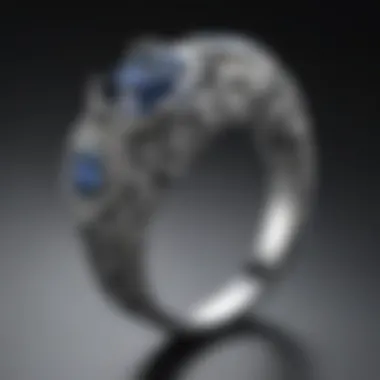
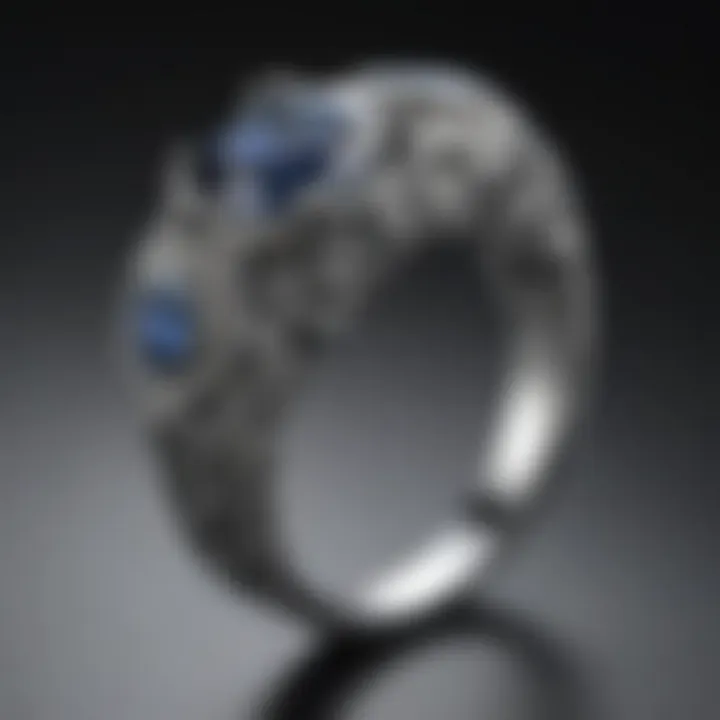
- Clear Transaction Receipts: Retaining all documentation aids in potential future disputes.
- Transparent Communication: It’s a good sign when retailers are upfront about their policies and practices.
In summary, whether you're drawn to the online world or the intimacy of a shop, the key is to be well-informed, diligent, and smart in your approach. With the right choices, purchasing a platinum ring can be one of the most rewarding experiences of your life.
Maintaining the Value of Platinum Rings
Platinum rings aren't just stunning pieces of art; they carry quite a bit of significance in terms of both monetary and emotional value. It's essential to maintain them properly to ensure that they not only look brand new but also hold onto their worth over time. This section will dive into the specific elements that contribute to keeping these precious rings in top-notch condition. Let's explore the benefits of maintenance, the factors that affect value, and practical tips for care and insurance considerations.
Care and Cleaning Tips
To keep a platinum ring looking its sparkling best, regular care is paramount. Here are some effective ways to maintain its shine:
- Gentle Cleaning: Use warm, soapy water with a soft cloth or a toothbrush to gently scrub your ring. Avoid harsh chemicals as they can lead to scratches and dullness.
- Storing Properly: When not being worn, platinum rings should be stored separately to prevent scratches from harder materials. A fabric-lined box works wonders.
- Regular Inspections: Periodically inspecting the ring for loose stones or wear can save you from costly repairs down the road. Catching such issues early may keep the ring in prime health.
Taking meticulous care of your platinum jewelry prevents common wear and tear and helps it retain its allure for years to come.
Insurance Considerations
Types of Jewelry Insurance
When it comes to protecting your investment, jewelry insurance is a wise move. Various policies cater specifically to jewelry, including standalone coverage and adding a rider to a homeowner's policy. These specialized insurance plans often provide replacement cost coverage, which means they will pay for a like-kind replacement if your ring is lost or stolen.
- Standalone Policies: These are dedicated to jewelry and typically cover loss, theft, or damage for a specified amount.
- Rider Policies: These allow you to add coverage to your existing homeowner’s insurance, often making them cheaper. However, they might not always provide comprehensive benefits like standalone plans do.
Each option has its unique advantages, but the crucial factor is that having insurance protects not just the ring but also offers peace of mind.
Factors Affecting Premiums
Several factors influence the premiums of jewelry insurance, and understanding them can help you make an informed decision:
- Value of the Ring: The higher the appraised value, the more you can expect to pay for coverage. A platinum ring's intrinsic value can elevate your insurance costs.
- Location: Living in a high-crime area may result in higher premiums as the perceived risk increases.
- Claim History: If you’ve had previous claims, insurers might perceive you as a higher risk, which could spike your rates.
Taking all these elements into account will help you choose the best insurance policy for your platinum ring. Keeping it safe with proper care and coverage ensures it remains not just a cherished possession but also a valuable asset.
Cultural and Emotional Significance
In examining platinum rings, it's essential to delve into their cultural and emotional significance, as these elements often sway buyers' decisions just as much as the tangible attributes of the metal itself. Platinum's legacy transcends mere material wealth; it encapsulates milestones and heartfelt commitments, weaved into the human experience.
Symbolism in Relationships
A platinum ring isn't just an accessory; it carries profound meaning, especially in romantic relationships. The durability and rarity of platinum symbolize enduring love and commitment. When someone chooses to propose with a platinum ring, it can be interpreted as a vow of everlasting fidelity. The metal’s resilience is a fitting metaphor for the strength that couples aspire to nurture in their bond.
Platinum rings are not just about the initial proposal. They often celebrate anniversaries or significant life events. Whether it's a wedding, a milestone birthday, or the birth of a child, these rings serve as tangible reminders of love and shared experiences. Many people associate platinum with perfection because of its lustrous appearance and unique qualities, further elevating its role in romantic symbolism.
"A gift of platinum transcends its physical beauty and reflects the depths of one’s emotions."
Heritage and Family Legacy
Beyond romantic associations, platinum rings often carry the weight of familial legacy. In many cultures, a ring can become a cherished heirloom, passed down from generation to generation. This practice is not merely about the ring’s monetary value; it’s about the stories it carries—the love stories, the triumphs, and even the trials of those who wore it before.
Owning an heirloom platinum ring offers a connection to one’s roots, weaving personal history with the resplendent qualities of the metal. Families often cherish the narratives that evolve around these pieces, incorporating them into life celebrations, thus enriching their significance further.
Platinum, being rarer than gold or silver, adds an additional layer of esteem. The lineage of a family can be honored through a platinum ring, which embodies not just personal history but a continuity of love and values over time.
In summary, the cultural and emotional significance of platinum rings goes far beyond their aesthetic appeal. They touch on relationships and heritage, creating a multi-layered understanding of why these rings hold such a high value in people’s hearts.
The End
In summing up the discussion about platinum rings, it’s crucial to recognize their multi-faceted value. This article has taken a closer look at everything from market trends to craftsmanship, offering a rich tapestry of information that highlights how and why platinum rings hold their worth. The inherent properties of platinum—its rarity, strength, and allure—combine with cultural significance to form a type of investment and a symbol of commitment.
Through our exploration, several key elements emerge:
- Market Dynamics: The fluctuating demand affects pricing strategies not just for buyers but also for sellers. Awareness of market trends can guide your purchases.
- Craftsmanship: Elevation in value often comes from skillful design and superior workmanship. Unique designs may not only enhance aesthetic appeal but also influence resale value significantly.
- Emotional Significance: Beyond material worth, platinum rings often symbolize milestones in life—weddings, anniversaries, and personal achievements.
The careful consideration of these factors empowers potential buyers and collectors to navigate the market with confidence. Investing in platinum rings can indeed be a nuanced journey—a blend of personal taste and financial savvy.
Recapitulating Key Points
By assessing the layers of value attached to platinum rings, it becomes clear that their worth goes beyond mere market prices. Understanding their unique properties, social and emotional significance, and the importance of craftsmanship is vital. As you've read through the sections, recall how each element contributes to the tapestry that makes platinum rings not just pieces of jewelry but also cherished possessions that can carry meaning through generations. With this deeper grasp, one can appreciate these rings for what they truly are: a combination of art, history, and investment.
Future Outlook for Platinum in Jewelry
Looking ahead, the future of platinum in jewelry continues to shine. Trends suggest a growing demand for sustainable and ethically sourced materials, and platinum fits the bill nicely. Its durability and long-lasting appeal may push more designers and consumers to favor platinum over other precious metals like gold or silver.
- Increasing Customization: As consumers seek uniqueness, the market is likely to favor customized platinum pieces that reflect personal stories and preferences.
- Technological Advances: Innovations in jewelry design and production may offer new ways to enhance the beauty and quality of platinum rings.
- Cultural Shifts: As attitudes towards marriage and gifting evolve, platinum's symbolic nature can maintain its relevance in new cultural contexts.
As trends develop, staying informed will be paramount for enthusiasts and collectors alike. Keeping an ear to the ground on changes within the industry and a finger on the pulse of cultural shifts will help anyone navigate this magnificent world of precious metals and stones.



